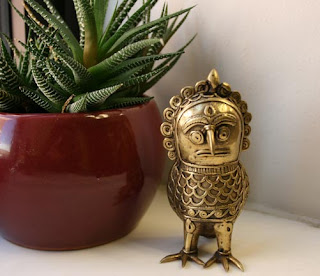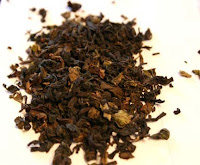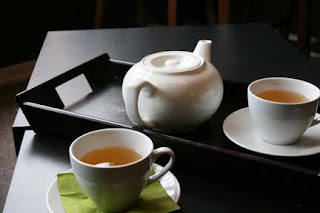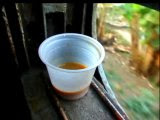Tea and Chai have certainly journeyed well out of India and taken root in distant lands such as Ann Arbor, Michigan. But now we have globalization to blame for such redundancies as Chai Tea Latte - staple beverages at Starbucks, Espresso Royale or Borders, to say nothing of packaged products from say Oregon Chai, Chai concentrates and flavored Chai tea bags with spices mixed in.
In Hindi Chai means tea, so to say Chai Tea is redundant. We wouldn't want to say Tea Tea, would we? To add Latte to the mix is introducing another country and idea, leading to a confusion in terminology as well as concept and taste. But some of this mingling of influences is inevitable and in my opinion it is best to just observe and smile. After all, don't Indians in India savor the morphed taste of distinctly Indian/curried Chinese food? How about McAloo Tikki Burgers? Or Keema Do Pyaaza and Paneer Tikka topped Domino's pizza? So can we really complain about the worldwide proliferation of Chai Tea?
As we (happily) live with some of this confusion in taste and nomenclature, I want to mention TeaHaus, a wonderful haven for tea connoisseurs, right by the historic Kerrytown in Ann Arbor.
Tea Haus, 204 North 4th Avenue, Ann Arbor. Photo: Sreyashi Dey, 2010
On a cool, rainy morning a couple of weeks ago, I sat down with Lisa McDonald, the owner of TeaHaus for a cup of tea and conversation. Lisa opened her place in December 2007, when her second son was only 5 days old. Originally from Colorado, she met her husband, an Ann Arbor native, in Germany. Germany, the world's largest tea purchasing country (especially Darjeeling), is also where Lisa got introduced to the wonderful world of real tea. (As an interesting aside, Germany has the world's largest Ayurvedic centers.) When one of the shops there offered a tea sommelier course, Lisa signed up, thinking of it as a fun hobby. But back in Ann Arbor some years later, she missed good tea and bread. But being sure that she didn't want to wake up at 3am every morning to bake, her other option was to open a tea shop of her own. Nine months of planning and TeaHaus was ready to open. Lisa McDonald in conversation. Photo: Sreyashi Dey, 2010
TeaHaus carries around 200 classic black and green, Oolong, white, herbal, Ayurvedic, fruit, aroma, Rooibus and seasonal teas. "I feel that although it is in its infancy now, in about ten years time, the US will become competitive in the world tea market," says Lisa. She gets all her tea supplies from Germany where they are rigorously tested before sales.
The impressive stock of loose leaf tea at TeaHaus. Photo: Sreyashi Dey, 2010
I talked to Lisa specifically about tea from India. Almost a third of all the tea she carries is from India, while the rest are Japanese and Chinese teas. The wonderful range of her Indian tea includes Darjeeling, Assam, Ceylon, Sikkim and Nilgiris, as well as Ayurvedic, blends and flavored teas. All of this tea is purchased directly in the tea gardens and not in commodities markets in larger Indian cities such as Kolkata. She mentioned that some of these tea plants are very, very old...I imagined them as age-ripened old men and women, mellow and rich with experience, with many stories to tell, surviving the ravages of time but continuing to thrive.
India is known for its fully oxidized black tea. But tea growers in India are cognizant of the world trends toward green and white teas. As a result, there is now a green Darjeeling, a Nilgiri Jasmine (dark green) and a South Indian white tea. Although deeply rooted in traditional tea culture, India is now more innovative and marketing savvy, making itself competitive in the world tea market.
I asked Lisa about her customer base. Characterizing her customers in general, Lisa says, "Most of my customers are foodies, wine drinkers and connoisseurs of specialty items in general." However, her typical customer comes in with only enough information to ask for either black or green tea. At that point, Lisa or Andrew who works at TeaHaus full time, makes suggestions. The number one bestseller is Earl Grey, followed by Indian Chai which can be in two forms - one with the masala or spices already blended in with the tea and the other where the masala is added separately. More Indians come to her shop now and they are a little more discerning than the average customer. I found it very interesting that she has noticed that for some Indians, walking into her shop and discovering this world of tea from India is a moment of regaining pride in the old country. As I had mentioned in my last post, many Indians are not very aware of the finer distinctions between the different varieties of tea, so it takes a tea shop in Ann Arbor to open this world for some! All power to globalization!

Andrew at TeaHaus. Photo: Sreyashi Dey, 2010
I was gratified to learn that TeaHaus is doing very well business wise, which means that it will be around for those of us that crave access to good tea locally. And with a wide variety of tea accessories that the shop carries and periodic tea-tasting events, it is quite a full experience.
 Photo: Sreyashi Dey, 2010
Photo: Sreyashi Dey, 2010 
























